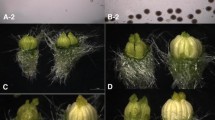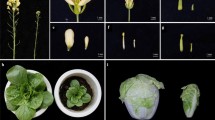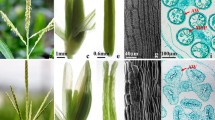Abstract
Key message
The ms3 gene responsible for a male-sterile phenotype in cabbage was mapped to a 187.4-kb genomic fragment. The gene BoTPD1, a homolog of Arabidopsis TPD1, was identified as a strong candidate gene.
Abstract
Cabbage 51S is a spontaneous male-sterile mutant. Phenotypic investigation revealed defects in anther cell differentiation, with failure to form the tapetum layer and complete abortion of microsporocytes before the tetrad stage. Genetic analysis indicated that this male sterility was controlled by a single recessive gene, ms3. Using an F2 population, we mapped ms3 to a 187.4-kb interval. BoTPD1 was identified as a candidate from this interval. Sequence analysis revealed an intronic 182-bp insertion in 51S that interrupted the conserved motif at the 5′ splicing site of the third intron, possibly resulting in a truncated transcript. Analyses of BoTPD1 homologous proteins revealed evolutionarily conserved roles in anther cell fate determination during reproductive development. RT-PCR showed that BoTPD1 was expressed in various tissues, excluding the root, and high expression levels were detected in anthers and buds. A BoTPD1-specific marker based on the 182-bp insertion cosegregated with male sterility and can be used for marker-assisted selection.






Similar content being viewed by others
References
Abe Y, Mieda K, Ando T, Kono I, Yano M, Kitano H, Iwasaki Y (2010) The SMALL AND ROUND SEED1 (SRS1/DEP2) gene is involved in the regulation of seed size in rice. Genes Genet Syst 85:327–339
Balk J, Leaver CJ (2001) The PET1-CMS mitochondrial mutation in sunflower is associated with premature programmed cell death and cytochrome c release. Plant Cell 13:1803–1818
Blackmore S, Wortley AH, Skvarla JJ, Rowley JR (2007) Pollen wall development in flowering plants. New Phytol 174(3):483–498
Carmel I, Tal S, Vig I, Ast G (2004) Comparative analysis detects dependencies among the 5′ splice-site positions. RNA 10:828–840
Chang Z, Chen Z, Wang N, Xie G, Lu J, Yan W, Zhou J, Tang X, Deng XW (2016) Construction of a male sterility system for hybrid rice breeding and seed production using a nuclear male sterility gene. Proc Natl Acad Sci 113:14145–14150
Chen L, Liu Y (2014) Male sterility and fertility restoration in crops. Annu Rev Plant Biol 65:579–606
Fang Z, Sun P, Liu Y, Yang L, Wang X, Hou A, Bian C (1997) A male sterile line with dominant gene (Ms) in cabbage (Brassica oleracea var. capitata) and its utilization for hybrid seed production. Euphytica 97:265–268
Feng X, Dickinson HG (2010) Tapetal cell fate, lineage and proliferation in the Arabidopsis anther. Development 137:2409–2416
Fox T, DeBruin J, Haug Collet K, Trimnell M, Clapp J, Leonard A, Li B, Scolaro E, Collinson S, Glassman K, Miller M, Schussler J, Dolan D, Liu L, Gho C, Albertsen M, Loussaert D, Shen B (2017) A single point mutation in Ms44 results in dominant male sterility and improves nitrogen use efficiency in maize. Plant Biotechnol J 15:942–952
Han F, Yang C, Fang Z, Yang L, Zhuang M, Lv H et al (2015) Inheritance and InDel markers closely linked to petal color gene (cpc-1) in Brassica oleracea. Mol Breed 35:160
Han F, Zhang X, Liu X, Su H, Kong C, Fang Z et al (2017) Comparative analysis of genome wide DNA methylation profiles for the genic male sterile cabbage line 01-20S and its maintainer line. Genes 8:159
Hong L, Tang D, Shen Y, Hu Q, Wang K, Li M et al (2012) MIL2 (MICROSPORELESS2) regulates early cell differentiation in the rice anther. New Phytol 196:402–413
Huang J, Zhang T, Linstroth L, Tillman Z, Otegui MS, Owen HA, Zhao D (2016) Control of anther cell differentiation by the small protein ligand TPD1 and its receptor EMS1 in Arabidopsis. PLoS Genet 12:e1006147
Ito T, Shinozaki K (2002) The MALE STERILITY1 gene of Arabidopsis, encoding a nuclear protein with a PHD-finger motif, is expressed in tapetal cells and is required for pollen maturation. Plant Cell Physiol 43:1285–1292
Ji J, Yang L, Fang Z, Zhuang M, Zhang Y, Lv H, Liu Y, Li Z (2017) Recessive male sterility in cabbage (Brassica oleracea var. capitata) caused by loss of function of BoCYP704B1 due to the insertion of a LTR-retrotransposon. Theor Appl Genet 130:1441–1451
Jia G, Liu X, Owen HA, Zhao D (2008) Signaling of cell fate determination by the TPD1 small protein and EMS1 receptor kinase. Proc Natl Acad Sci USA 105:2220–2225
Jung H, Lee D, Lee J, Park D, Kim YJ, Park WY et al (2015) Intron retention is a widespread mechanism of tumor-suppressor inactivation. Nat Genet 47:1242
Katoh K, Standley DM (2013) MAFFT multiple sequence alignment software version 7: improvements in performance and usability. Mol Biol Evol 30:772–780
Kelliher T, Walbot V (2011) Emergence and patterning of the five cell types of the Zea mays anther locule. Dev Biol 350:32–49
Laberge-le Couteulx S, Jung HH, Labauge P, Houtteville JP, Lescoat C, Cecillon M et al (1999) Truncating mutations in CCM1, encoding KRIT1, cause hereditary cavernous angiomas. Nat Genet 23:189
Lewandowska MA (2013) The missing puzzle piece: splicing mutations. Int J Clin Exp Pathol 6:2675
Liang J, Ma Y, Wu J, Cheng F, Liu B, Wang X (2017) Map-based cloning of the dominant genic male sterile Ms-cd1 gene in cabbage (Brassica oleracea). Theor Appl Genet 130:71–79
Liu S, Liu Y, Yang X, Tong C, Edwards D, Parkin IA (2014) The Brassica oleracea genome reveals the asymmetrical evolution of polyploid genomes. Nat Commun 5:3930
Liu X, Han F, Kong C, Fang Z, Yang L, Zhang Y et al (2017) Rapid introgression of the Fusarium wilt resistance gene into an elite cabbage line through the combined application of a microspore culture, genome background analysis, and disease resistance-specific marker assisted foreground selection. Front Plant Sci 8:354
Lou P, Kang J, Zhang G, Bonnema G, Fang Z, Wang X (2007) Transcript profling of a dominant male sterile mutant (Ms-cd1) in cabbage during flower bud development. Plant Sci 172:111–119
Lv H, Yang L, Kang J, Wang Q, Wang X, Fang Z et al (2013) Development of InDel markers linked to Fusarium wilt resistance in cabbage. Mol Breed 32:961–967
Lv H, Fang Z, Yang L, Zhang Y, Wang Q, Liu Y et al (2014) Mapping and analysis of a novel candidate Fusarium wilt resistance gene FOC1 in Brassica oleracea. BMC Genomics 15:1094
Lv H, Wang Q, Han F, Liu X, Fang Z, Yang L et al (2017) Genome-wide indel/SSR scanning reveals significant loci associated with excellent agronomic traits of a cabbage (Brassica oleracea) elite parental line ‘01–20’. Sci Rep 7:41696
McCormick S (1993) Male gametophyte development. Plant Cell 5:1265–1275
Pelletier G, Primard C, Vedel F, Chetrit P, Remy R, Renard M (1983) Intergeneric cytoplasmic hybridization in Cruciferae by protoplast fusion. Mol Genet Genomics 191:244–250
Perez-Prat E, van Lookeren Campagne MM (2002) Hybrid seed production and the challenge of propagating male-sterile plants. Trends Plant Sci 7:199–203
Piffanelli P, Ross JHE, Murphy DJ (1998) Biogenesis and function of the lipidic structures of pollen grains. Sexual Plant Reprod 11:65–80
Price MN, Dehal PS, Arkin AP (2009) FastTree: computing large minimum evolution trees with profiles instead of a distance matrix. Mol Biol Evol 26:1641–1650
Reddy ASN, Marquez Y, Kalyna M, Barta A (2013) Complexity of the alternative splicing landscape in plants. Plant Cell 25:3657–3683
Rogozin IB, Carmel L, Csuros M, Koonin EV (2012) Origin and evolution of spliceosomal introns. Biol Direct 7:11
Ruffio-Chable V, Bellis H, Herve Y (1993) A dominant gene for male sterility in cauliflower (Brassica oleracea var. botrytis): phenotype expression, inheritance, and use in F1 hybrid production. Euphytica 67:9–17
Sampson DR (1966) Linkage of genetic male sterility with a seedling marker and its use in producing F1 hybrid seed of Brassica oleracea (cabbage, broccoli, kale, etc.). Can J Plant Sci 46:703
Scott RJ, Spielman M, Dickinson HG (2004) Stamen structure and function. Plant Cell 16(Suppl):S46–S60
Simpson CG, McQuade C, Lyon J, Brown JW (1998) Characterization of exon skipping mutants of the COP1 gene from Arabidopsis. Plant J 15:125–131
Umen JG, Guthrie C (1995) A novel role for a U5 snRNP protein in 3′ splice site selection. Genes Dev 9:855–868
Wang XW, Lou P, Bonnema G, Yang BJ, He HJ, Zhang YG, Fang ZY (2005) Linkage mapping of a dominant male sterility gene Mscd1 in Brassica oleracea. Genome 48:848–854
Wang C, Nan G, Kelliher T, Timofejeva L, Vernoud V, Golubovskaya IN et al (2012) Maize multiple archesporial cells 1 (mac1), an ortholog of rice TDL1A, modulates cell proliferation and identity in early anther development. Development 139:2594–2603
Yang S, Xie L, Mao H, San Puah C, Yang W, Jiang L et al (2003) Tapetum determinant1 is required for cell specialization in the Arabidopsis anther. Plant Cell 15:2792–2804
Zhang D, Yang L (2014) Specification of tapetum and microsporocyte cells within the anther. Curr Opin Plant Biol 17:49–55
Zhang D, Wu S, An X, Xie K, Dong Z, Zhou Y, Xu L, Fang W, Liu S, Liu S, Zhu T, Li J, Rao L, Zhao J, Wan X (2018) Construction of a multi-control sterility system for a maize male-sterile line and hybrid seed production based on the ZmMs7 gene encoding a PHD-fnger transcription factor. Plant Biotechnol J 16:459–471
Acknowledgements
This work was supported by grants from the National Key Research and Development Program of China (2017YFD0101804), the Central Public-interest Scientific Institution Basal Research Fund (No. 1610102017013), the Science and Technology Innovation Program of the Chinese Academy of Agricultural Sciences (CAAS-ASTIP-IVFCAAS) and the earmarked fund for the Modern Agro-Industry Technology Research System, China (nycytx-35-gw01). The work reported here was performed in the Key Laboratory of Biology and Genetic Improvement of Horticultural Crops, Ministry of Agriculture, Beijing 100081, China.
Author information
Authors and Affiliations
Corresponding authors
Ethics declarations
Conflict of interest
The authors declare that they have no conflicts of interest to disclose.
Ethical approval
The authors declare that all experiments comply with the current laws of China.
Additional information
Communicated by Carlos F. Quiros.
Electronic supplementary material
Below is the link to the electronic supplementary material.
Rights and permissions
About this article
Cite this article
Han, F., Yuan, K., Kong, C. et al. Fine mapping and candidate gene identification of the genic male-sterile gene ms3 in cabbage 51S. Theor Appl Genet 131, 2651–2661 (2018). https://doi.org/10.1007/s00122-018-3180-9
Received:
Accepted:
Published:
Issue Date:
DOI: https://doi.org/10.1007/s00122-018-3180-9




